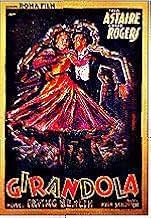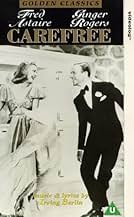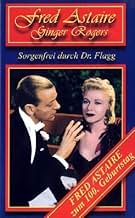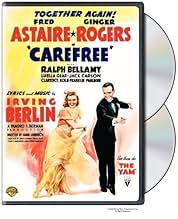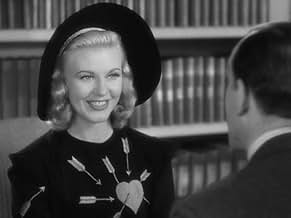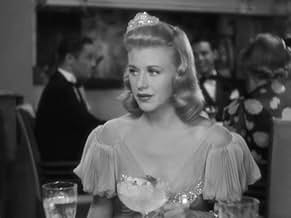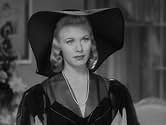NOTE IMDb
6,9/10
4,5 k
MA NOTE
Ajouter une intrigue dans votre langueA psychiatrist falls in love with the woman he's supposed to be nudging into marriage with someone else.A psychiatrist falls in love with the woman he's supposed to be nudging into marriage with someone else.A psychiatrist falls in love with the woman he's supposed to be nudging into marriage with someone else.
- Réalisation
- Scénario
- Casting principal
- Nommé pour 3 Oscars
- 3 victoires et 4 nominations au total
The Robert Mitchell Boy Choir
- Vocal Ensemble
- (scènes coupées)
- (as Robert B. Mitchell and his St. Brendan's Boys)
Harry A. Bailey
- Sponsor
- (non crédité)
Bobby Barber
- Minor Role
- (non crédité)
Cliff Bergere
- Minor Role
- (non crédité)
Ralph Brooks
- Country Club Guest
- (non crédité)
James P. Burtis
- Glass Truck Driver
- (non crédité)
Harry Campbell
- Minor Role
- (non crédité)
James Carlisle
- Country Club Guest
- (non crédité)
Charles Coleman
- Doorman
- (non crédité)
Avis à la une
Fred Astaire and Ginger Rogers star in this delightful romantic musical comedy with a twist on the usual Fred and Ginger plot. Though odd and short in the musical number department, this teasing romantic romp features some of their best dancing and good humor to boot. Ginger Rogers is nothing short of stunning in this picture and Mr. Astaire's feet never touch the ground. Definitely their most underrated film.
CAREFREE (RKO Radio, 1938), directed by Mark Sandrich, a screwball comedy set to music, reunites the song and dance team of Fred Astaire and Ginger Rogers for the eighth time in a sort of welcome change from their previous efforts: Astaire plays a doctor, psychiatrist by profession, rather than his usual lovesick American dancer, although the doctor in question DOES have a talent for dancing. Rogers, breaking away from sophisticated humor, makes her mark in broader comedy. She's been funny before, usually sassy with nifty comebacks, but this time in the dizzy-dame mode, but fortunately, not to the extreme.
The plot focuses on Stephen Arden (Ralph Bellamy), a witless attorney. He becomes drunk after his engagement to popular radio star, Amanda Cooper (Ginger Rogers), has been broken for the third time and stumbles to the Medical Foundation building to ask his good friend, Dr. Tony Flagg (Fred Astaire), a psychiatrist assisted by his white coated Connors (Jack Carson), to have Amanda "what's 'er name" analyzed. While waiting in his office, Amanda, accidentally stumbles upon Flagg's phonograph record, listening to a diagnosis about his last patient, closing with his comment about his next patient, Miss Cooper, being a "maladjusted woman." Upset, Amanda turns the tables around by sitting behind his desk and the doctor uncomfortably on the other end in a question and answer session. While bicycling in the park with Steven and her Aunt Cora (Luella Gaer), Amanda and Tony meet again, coming come to friendly terms. Agreeing to Tony's treatments, Amanda goes through a dinner special diet (lobster with mayonnaise and buttermilk) so to have her dreams analyzed, and hypnotism that turns to disaster when roaming the streets in a trance.
With plenty of comedy written into the screenplay, it's a wonder how dance numbers could fit into an overall "screwball" comedy, especially with a score by Irving Berlin. This is where CAREFREE stands apart from the other Astaire and Rogers films. The first number, "Since They Turned 'Loch Lamond' Into Swing" finds Astaire at a golf course accomplishing several things at the same time by playing the harmonica and tap dancing to a Scottish underscoring while teeing off several golf balls in rhythm, all to perfection without once missing his mark. There is no vocal to this number. "I Used to Be Color Blind" is very interesting mainly because it takes part as Rogers' dream dance, with Astaire, singing and dancing in slow motion. While "The Yam" sung by Ginger Rogers at the country club, is an upbeat number, followed by dancing with Astaire on wooden floors rather than the traditional glossy ones. It didn't become a memorable duet as "The Carioca," "The Continental" or "The Piccolino," but unlike these earlier dance numbers, which Fred and Ginger are the main focus, they invite dinner guests to join in with them. The final number, "Change Partners," a more appropriate title than "Carefree," is a beautiful love dance, or trance dance, where the hypnotized Rogers dances in a motionless manner with Astaire. While "Change Partners" is in slower tempo, it's one of the film's most memorable tune, it not, their most sentimental dance sequences. "Change Partners" earned an Academy Award nomination as Best Song.
Luella Gear, as Rogers' matron aunt, Cora, comes across as a middle-aged Kay Francis but speaking like Helen Broderick. Gear, in her movie debut, had very few films to her credit. She's reportedly best known for her role as Aunt Hortence in the stage version of THE GAY DIVORCE (1932) that starred Astaire. Ralph Bellamy, who by this time was usually type-cast as stuffy suitors, happens to be the most masculine of Rogers' rejected beaus thus far. His character, however, becomes very unlikable towards the second half, bogging down the story.
Rounding out the cast in smaller roles are Franklin Pangborn (Roland Hunter); and Hattie McDaniel (Hattie, the maid); and Kay Sutton (Miss Adams). Clarence Kolb takes support as the no-nonsense Judge Joe Travers, Stephen's friend who pleasure himself by telling corny jokes. Although credited, the Robert B. Mitchell and the St. Brendan's Boy Choir seem to have become victims of the editing process consider how they're nowhere to be seen, only heard on the soundtrack singing "Change Partners" near the film's close.
In spite of numerous pros and cons, CAREFREE ranks the team's most underrated film as shortest (83 minutes). It's occasionally funny in spots with imaginable, if not too successful, dance numbers. Other than CAREFREE being available on video cassette and DVD, and formerly found on American Movie Classics prior to 2001, it turns up occasionally (with close casting credits restored) on Turner Classic Movies. Next in the Astaire and Rogers series, THE STORY OF VERNON AND IRENE CASTLE (1939). (***)
The plot focuses on Stephen Arden (Ralph Bellamy), a witless attorney. He becomes drunk after his engagement to popular radio star, Amanda Cooper (Ginger Rogers), has been broken for the third time and stumbles to the Medical Foundation building to ask his good friend, Dr. Tony Flagg (Fred Astaire), a psychiatrist assisted by his white coated Connors (Jack Carson), to have Amanda "what's 'er name" analyzed. While waiting in his office, Amanda, accidentally stumbles upon Flagg's phonograph record, listening to a diagnosis about his last patient, closing with his comment about his next patient, Miss Cooper, being a "maladjusted woman." Upset, Amanda turns the tables around by sitting behind his desk and the doctor uncomfortably on the other end in a question and answer session. While bicycling in the park with Steven and her Aunt Cora (Luella Gaer), Amanda and Tony meet again, coming come to friendly terms. Agreeing to Tony's treatments, Amanda goes through a dinner special diet (lobster with mayonnaise and buttermilk) so to have her dreams analyzed, and hypnotism that turns to disaster when roaming the streets in a trance.
With plenty of comedy written into the screenplay, it's a wonder how dance numbers could fit into an overall "screwball" comedy, especially with a score by Irving Berlin. This is where CAREFREE stands apart from the other Astaire and Rogers films. The first number, "Since They Turned 'Loch Lamond' Into Swing" finds Astaire at a golf course accomplishing several things at the same time by playing the harmonica and tap dancing to a Scottish underscoring while teeing off several golf balls in rhythm, all to perfection without once missing his mark. There is no vocal to this number. "I Used to Be Color Blind" is very interesting mainly because it takes part as Rogers' dream dance, with Astaire, singing and dancing in slow motion. While "The Yam" sung by Ginger Rogers at the country club, is an upbeat number, followed by dancing with Astaire on wooden floors rather than the traditional glossy ones. It didn't become a memorable duet as "The Carioca," "The Continental" or "The Piccolino," but unlike these earlier dance numbers, which Fred and Ginger are the main focus, they invite dinner guests to join in with them. The final number, "Change Partners," a more appropriate title than "Carefree," is a beautiful love dance, or trance dance, where the hypnotized Rogers dances in a motionless manner with Astaire. While "Change Partners" is in slower tempo, it's one of the film's most memorable tune, it not, their most sentimental dance sequences. "Change Partners" earned an Academy Award nomination as Best Song.
Luella Gear, as Rogers' matron aunt, Cora, comes across as a middle-aged Kay Francis but speaking like Helen Broderick. Gear, in her movie debut, had very few films to her credit. She's reportedly best known for her role as Aunt Hortence in the stage version of THE GAY DIVORCE (1932) that starred Astaire. Ralph Bellamy, who by this time was usually type-cast as stuffy suitors, happens to be the most masculine of Rogers' rejected beaus thus far. His character, however, becomes very unlikable towards the second half, bogging down the story.
Rounding out the cast in smaller roles are Franklin Pangborn (Roland Hunter); and Hattie McDaniel (Hattie, the maid); and Kay Sutton (Miss Adams). Clarence Kolb takes support as the no-nonsense Judge Joe Travers, Stephen's friend who pleasure himself by telling corny jokes. Although credited, the Robert B. Mitchell and the St. Brendan's Boy Choir seem to have become victims of the editing process consider how they're nowhere to be seen, only heard on the soundtrack singing "Change Partners" near the film's close.
In spite of numerous pros and cons, CAREFREE ranks the team's most underrated film as shortest (83 minutes). It's occasionally funny in spots with imaginable, if not too successful, dance numbers. Other than CAREFREE being available on video cassette and DVD, and formerly found on American Movie Classics prior to 2001, it turns up occasionally (with close casting credits restored) on Turner Classic Movies. Next in the Astaire and Rogers series, THE STORY OF VERNON AND IRENE CASTLE (1939). (***)
there is something specific about watching fred astaire and ginger rogers that just makes you want to dance. i think it's because they make it look so damn fun. and they are just so astonishingly good!! the plot here is a tad crazier than, say "top hat", and therefore that much less believable (come on ... going all out with freud and hypnosis, but then again that's just speaking from what is known today, so no problem letting that pass). irving berlin's music is a hoot at times (there's a song about yams) and classic and familiar at others ("change partners") and ginger rogers is nearly at her sassy best.
If you attempt to look at the plot carefully (never a good idea in a musical) this is a rather repellent movie. The practice of Psychotherapy wasn't as well known or as well respected as it is today, and the film was clearly written by someone who seemed to think of it as some fad medical cure indulged in mainly by rich and foolish women. As such we get to see Fred Astaire, the therapist, subjecting Ginger Rogers, the patient, to all manner of barbaric (to modern eyes) treatments in order to find out why she won't marry his best friend. Eventually Astaire uses hypnosis to force her to marry him, and then force him not to. Clearly, movie doctors were not subjected to as severe a code of ethics as are real ones.
Its a pretty typical outing for Astaire and Rogers. Astaire's dancing is extraordinary (the dance scene on the golf course is great, as is the one where he dances with a hypnotized Rogers). Rogers' comic timing is, as always, wonderful. The secondary characters are all two-dimension cut-outs, but they're entertaining ones. If the characters didn't have quite the same sparkle to their interplay, remember, this was Astaire and Rogers' eighth film together and artistic differences were beginning to create a strain.
My biggest issue with this movie was the scene in which they sing the song "I Used To Be Colorblind". This was dream sequence, and it lasted about five minutes. "Carefree" is a black and white movie and the intent originally was to film the dream sequence in color a'la "Wizard of Oz". Apparently, somewhere in the production process, people balked at the cost and it was produced in black and white along with the rest of the film. Being filmed in black and white makes the song, and the entire sequence makes not one lick of sense, because the song is about how crisp and clear the world seems in color. Not only that, but since it was designed to be viewed on color film, not in black and white, the sets weren't designed with that same high degree of contrasts they would have if they had been designed to be viewed in black and white. As such, things in the dream sequence are LESS clear than in the rest of the movie, not more. I'm just appalled that the studio could spring for a few minutes of color footage for a film with such proved money-makes as Astaire and Rogers.
Its a pretty typical outing for Astaire and Rogers. Astaire's dancing is extraordinary (the dance scene on the golf course is great, as is the one where he dances with a hypnotized Rogers). Rogers' comic timing is, as always, wonderful. The secondary characters are all two-dimension cut-outs, but they're entertaining ones. If the characters didn't have quite the same sparkle to their interplay, remember, this was Astaire and Rogers' eighth film together and artistic differences were beginning to create a strain.
My biggest issue with this movie was the scene in which they sing the song "I Used To Be Colorblind". This was dream sequence, and it lasted about five minutes. "Carefree" is a black and white movie and the intent originally was to film the dream sequence in color a'la "Wizard of Oz". Apparently, somewhere in the production process, people balked at the cost and it was produced in black and white along with the rest of the film. Being filmed in black and white makes the song, and the entire sequence makes not one lick of sense, because the song is about how crisp and clear the world seems in color. Not only that, but since it was designed to be viewed on color film, not in black and white, the sets weren't designed with that same high degree of contrasts they would have if they had been designed to be viewed in black and white. As such, things in the dream sequence are LESS clear than in the rest of the movie, not more. I'm just appalled that the studio could spring for a few minutes of color footage for a film with such proved money-makes as Astaire and Rogers.
The upper-class Stephen Arden (Ralph Bellamy) brings his fiancée, the radio singer Amanda Cooper (Ginger Rogers), to be consulted by his friend, the psychoanalyst Dr. Tony Flagg (Fred Astaire), to improve their relationship. Amanda listens to the record made by Dr. Flagg about her and has an initial friction with the shrink. But sooner she falls in love with him and discloses her feelings to Dr. Flagg. He decides to hypnotize Amanda to loath him and love Stephen. However his subconscious makes him perceive that he also loves Amanda. But Stephen obtains a restrain order against his friend and he can not get close to Amanda to withdrawal his former hypnotic suggestion.
"Carefree" is a delightfully naive and adorable classic, with a silly story but wonderful dance numbers of the constant pair Fred Astaire and Ginger Rogers. Ginger "steals" the film not only dancing, but also with a funny performance. My vote is seven.
Title (Brazil): "Dance Comigo" ("Dance with Me")
"Carefree" is a delightfully naive and adorable classic, with a silly story but wonderful dance numbers of the constant pair Fred Astaire and Ginger Rogers. Ginger "steals" the film not only dancing, but also with a funny performance. My vote is seven.
Title (Brazil): "Dance Comigo" ("Dance with Me")
Le saviez-vous
- AnecdotesThis was the first Fred Astaire-Ginger Rogers film to lose money on its initial release. It lost $68,000 (~ $1.48M in 2024) for RKO according to studio records.
- GaffesAs Amanda (Ginger Rogers) exits the taxicab and starts to cross the street for the theatre, you can see the reflection of the roof line behind her in the large piece of plate glass on the truck. On the roof line, you can see the rigging pipes for lights and other equipment showing it's a back lot set.
- Citations
Stephen Arden: [drunkenly] Oh, uh, could you give me a little information?
Doorman: Yes sir.
Stephen Arden: Thank you.
[walks away]
- Crédits fousDuring opening credits, a pair of hands finger-paints names, pauses, wipes them out, and writes the next set of names several times.
- ConnexionsFeatured in Fred Astaire: Puttin' on His Top Hat (1980)
- Bandes originalesSince They Turned Loch Lomond into Swing
(1938) (uncredited)
Music by Irving Berlin
Danced by Fred Astaire
Meilleurs choix
Connectez-vous pour évaluer et suivre la liste de favoris afin de recevoir des recommandations personnalisées
- How long is Carefree?Alimenté par Alexa
Détails
Box-office
- Budget
- 1 253 000 $US (estimé)
- Durée1 heure 23 minutes
- Couleur
- Rapport de forme
- 1.37 : 1
Contribuer à cette page
Suggérer une modification ou ajouter du contenu manquant

